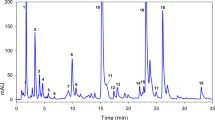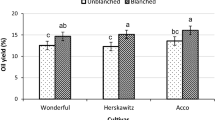Abstract
The present investigation was conducted to study the concentration of ascorbic acid and β-carotene in spinach and amaranth leaves as affected by various domestic processing and cooking methods which included storage of leaves in polythene bags or without packing for 24 and 48 hours in refrigerator at 5 °C; at 30 °C in polythene bags; drying (sun and oven); blanching (5, 10, 15 min); open pan and pressure cooking. Ascorbic acid content of fresh leaves was 624.1 to 629.0 mg and β-carotene content was 35.3 to 53.1 mg/100 g dry weight. The percent loss of ascorbic acid ranged from 1.1 to 6.3 and 55.3 to 65.9 while lower losses (0.0 to 1.3 and 1.5 to 2.1) of β-carotene were observed in leaves stored in refrigerator and at 30 °C, respectively. A markedly greater reduction in ascorbic acid and β-carotene was observed in dried, blanched and cooked leaves. The study recommended the storage of leaves in refrigerator, drying in oven, blanching for shorter time and cooking in pressure cooker for better retention of these two vitamins.
Similar content being viewed by others
References
Gopalan C, Ramasastri BV, Balasubramanian SC (1982). In: Nutritive value of Indian foods, New Delhi: ICAR, pp. 41, 64–72.
Thylefors B (1985) Prevention of blindness, the current focus. WHO Chronicle 39(4): 150.
Gopalan C (1992) New dimensions of ‘old problems’. In: Nutrition in developmental transition in South-East Asia. New Delhi: WHO Regional Office for South-East Asia, pp. 34–48.
Gopalan C, Ramasastri BV, Balasubramanian SC (1971) Nutritive value of Indian foods. Hyderabad: Indian Council of Medical Research, pp. 27–48.
Osborne DR, Voogt P (1978) Water-soluble vitamins. In: The analysis of nutrients in foods. London: Academic Press, pp. 230–232.
AOAC (1980) Official Methods of Analysis of the Association of Official Agricultural Chemists ed. B 125. Washington, DC: Association of Official Agricultural Chemists.
Snedecor GW, Cochran WG (1967) Statistical Methods. Ames: Iowa State University Press.
Sood R, Bhat CM (1974) Changes in ascrobic acid and carotene content of green leafy vegetables on cooking. J Food Sci Technol 11: 131–133.
Gopalan C, Ramasastri BV, Balasubramanian SC, Narasingha Rao BS, Deos-thale YG, Pant KC (1989) Nutritive value of Indian foods, Hyderabad, India: National Institute of Nutrition, ICMR, pp. 60–61.
Oke OL (1968) Chemical changes in some Nigerian vegetables during growth. Exp Agric 4: 345–349.
Stepanova EN, Grigoreva MP, Smirnova EV (1973) Estimation of vitamin C in fresh vegetables. Vopr Pitan 32(3): 58–60.
Dobreanu N, Cherghi A, Margineanu L, Ionescu E, Pirvulescu D, Amarriutei A, Citubotea A, Fugel S, Iordachescu O (1988) Nutritive value of some green vegetables and perishable fruits and biological and chemical changes that may occur during their marketing. Lucrari Stintifice-Institutional de cercetari Si Proiectari pentru Valorificarea si Industrializarea Legumelor si Fructelor 19: 47–54.
Bartosova L (1970) Changes in vitamin C content in vegetables after harvesting. Vyziva a Zdravie 15(2): 30–31.
Zacharias R (1970) Short term cool storage of ready prepared meals. Ernahrungs-Unachau 17(3): 92–97.
Ranganath DR, Dubash PJ (1981) Loss of colour and vitamin on dehydration of vegetable. Indian Food Packer 35(4): 4–10.
Sehgal KK, Kawatra BL, Bajaj S (1975) Studies on the nutritive value of sundried green leafy vegetables. J Food Sci Technol 12(6): 303–305.
Mohammed N, Ehteschamuddin AFM (1975) Optimum blanching time and effect of blanching and sulphiting on vitamin C content of dehydrated vegetables. Pakistan J Scientific Research 25(1/2): 157–161.
Astier-Dumas M (1975) Effect of cooking on nitrates, vitamins C, magnesium and iron content of spinach. Annals de la Nutrition et de l'Alimentation 29(3): 239–244.
Ajayi SD, Oderinde SF, Osibanjo O (1980) Vitamin C losses in cooked fresh leafy vegetables. Food Chem 5(3): 243–247.
Akpapunam MA (1984) Effect of wilting, blanching and storage temperature on ascorbic acid and total carotenoids content of some Nigerian fresh vegetables. Qual Plant: Plant Foods Hum Nutr 34(3): 177–180.
Kamalnathan G, Saraswathi G, Devadas RP (1972) Calcium, iron, thiamin, ascorbic acid content of three vegetables cooked by three methods. Indian J Nutr Dietet 9(4): 202–205.
Gordon J, Noble I (1959) Effect of cooking method on vegetables. Ascorbic acid retention and color differences. J Am Diet Assoc 35: 578–581.
Lane RH, Boschang MD, Abdel-Ghany M (1985) Ascorbic acid retention of selected vegetables blanched by microwave and conventional methods. J Food Quality 8(2/3): 139–144.
Bender AF (1967) Dietetic foods, London: Leonard Hill Books, 217 pp.
Author information
Authors and Affiliations
Rights and permissions
About this article
Cite this article
Yadav, S.K., Sehgal, S. Effect of home processing on ascorbic acid and β-carotene content of spinach (Spinacia oleracia) and amaranth (Amaranthus tricolor) leaves. Plant Food Hum Nutr 47, 125–131 (1995). https://doi.org/10.1007/BF01089261
Received:
Accepted:
Issue Date:
DOI: https://doi.org/10.1007/BF01089261




